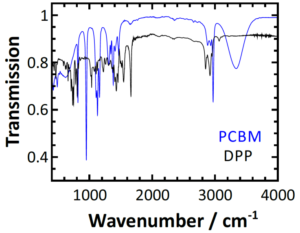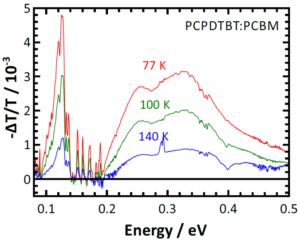Simon Kahmann
Simon Kahmann, M.Sc.
Project description
The fingerprint of charges for many conducting and semiconducting materials can be observed in the near to mid infrared (NIR – MIR) spectral region. The MIR regime furthermore contains information on the coupling of charge carriers to the lattice/backbone of the nanomaterial – the coupling between electronic and vibrational transitions. Time resolved and temperature dependent investigations at low photon energies between 400 and 4000 cm-1 , i.e. in the mid infrared (MIR) spectral region, therefore, reveal essential material and device related properties for conducting and semiconducting nanomaterials.
Using an extended Fourier transform infrared (FTIR) spectrometer, we are able to measure photoinduced phenomena both in steady state and with a ns time resolution. An extension to the FTIR spectroscopy is the so-called Fourier Transformed Photocurrent Spectroscopy (FTPS), which allows to determine the photoresponse of solar cells or photodetectors for the same broad spectral region. A special sample holder allows to carry out these experiments over a temperature range spanning from 4 to 600 K. In-situ FTIR PIA and FTPS measurements are therefore a powerful technique to study the temperature dependent behaviour of charges.
Investigations are focused, but not limited to:
- charge carriers in organic semiconductors and multicomponent semiconductor blends as typically used for organic photovoltaics. Special focus is placed on the temperature dependence of the polymer chain confirmation and the location of carriers in ternary systems.
- electrical trap states of inorganic colloidal quantum dots (CQD) and their dependence on surface passivating ligands
- long lived species in polymer wrapped single wall carbon nanotubes (CNT) and the interplay of the tubes with different wrapping polymers

Figure 1: MIR transmission spectra of conjugated polymer and the fullerene derivative PCBM.

Figure 2: PIA spectra of a blend for organic photovoltaics measured at different temperatures.

